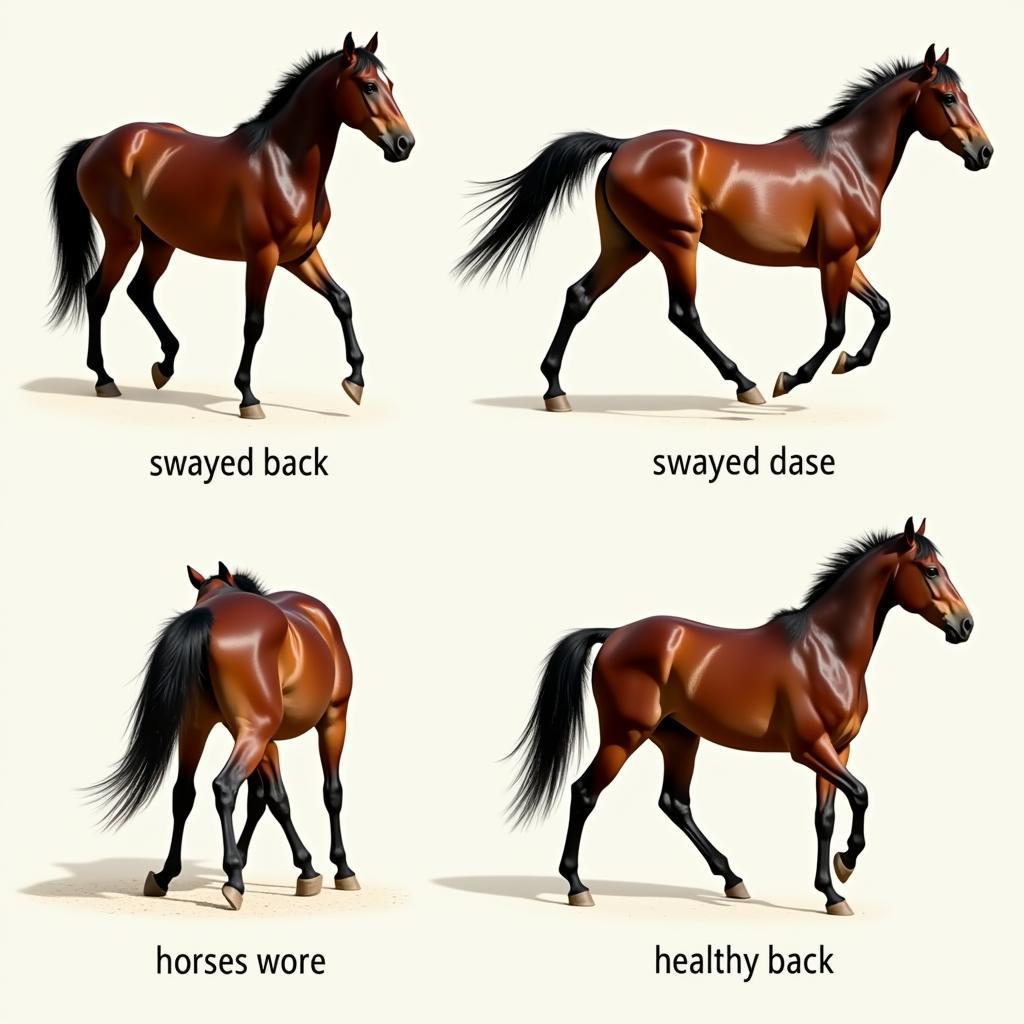A Swayed Back Horse, also known as lordosis, is a condition characterized by a dip or sagging in the back, just behind the withers. This can range from a slight dip to a pronounced sway, and understanding its causes, implications, and management is crucial for any horse owner. This article dives into the details of swayed backs in horses, providing valuable information for recognizing, managing, and caring for horses with this condition.
What causes a swayed back in a horse? This is a common question among horse owners. Several factors can contribute to a swayed back, including age, conformation, pregnancy, poor nutrition, and improper riding techniques. Sometimes, a horse may be born with a predisposition to a swayed back, but more often, it develops over time. Let’s explore these causes in more detail.
Causes of a Swayed Back in Horses
Age-Related Sway Back
As horses age, the ligaments and muscles supporting their spine can weaken, leading to a gradual sagging of the back. This is particularly common in older horses and ponies. Just like humans, horses experience age-related changes that can affect their physical condition.
Conformation and Genetics
Some horses are simply more prone to developing a swayed back due to their inherent conformation. This can be influenced by genetics and breed predispositions. For instance, some breeds are naturally longer-backed and may be more susceptible to developing a sway.
Pregnancy and Lactation
The weight of carrying a foal and the subsequent demands of lactation can place significant stress on a mare’s back, often resulting in a temporary or even permanent sway. Proper nutrition and management during and after pregnancy are crucial to minimizing the risk of a swayed back.
Poor Nutrition and Management
Inadequate nutrition can weaken a horse’s muscles and bones, making them more susceptible to developing a swayed back. Similarly, improper saddle fit and riding techniques can also contribute to this condition. Ensuring your horse receives a balanced diet and appropriate exercise is essential. Looking for horses for sale sarasota? Make sure to check their conformation carefully.
 Swayed Back Horse Causes: Nutrition and Management
Swayed Back Horse Causes: Nutrition and Management
Improper Riding and Training
Incorrect riding techniques, such as constantly pulling on the reins or riding in a hollow frame, can strain the horse’s back muscles and contribute to a swayed back. Proper training and riding are essential for maintaining a healthy back. Learn how do you measure a horse for a saddle to ensure a proper fit.
Recognizing a Swayed Back Horse
How can you tell if your horse has a swayed back? The most obvious sign is a visible dip or sagging in the back, just behind the withers. However, the severity can vary, and sometimes it might be subtle. Other signs can include difficulty maintaining a topline, muscle wastage along the back, and changes in gait. It’s essential to consult with a veterinarian or equine professional for a proper diagnosis.
 Swayed Back Horse: Recognizing Changes in Gait
Swayed Back Horse: Recognizing Changes in Gait
Managing a Swayed Back Horse
While a swayed back cannot be completely reversed, it can be managed effectively to minimize discomfort and improve the horse’s quality of life. This involves a combination of proper nutrition, exercise, and other supportive measures.
Nutritional Management
Providing a balanced diet rich in essential vitamins and minerals is crucial for supporting muscle and bone health. If you’re considering horses for sale near me under 1000, remember that proper nutrition is key, regardless of price.
Exercise and Physical Therapy
Targeted exercises and physical therapy can help strengthen the back muscles and improve posture. Consult with an equine veterinarian or therapist to develop a suitable exercise program. You might also consider looking at before and after sway back horse photos to understand the potential improvements.
Saddle Fit and Riding Techniques
Ensuring a properly fitted saddle is essential for distributing weight evenly and minimizing strain on the back. Correct riding techniques also play a vital role in supporting a healthy back. Think about a butter horse, smooth and comfortable, and strive for that in your riding.
 Swayed Back Horse Management: Saddle Fit and Riding
Swayed Back Horse Management: Saddle Fit and Riding
Conclusion
A swayed back horse requires careful management and understanding. By addressing the underlying causes and implementing appropriate management strategies, you can help your horse live a comfortable and fulfilling life. Remember, early detection and intervention are crucial for minimizing the long-term effects of a swayed back.
FAQ
- Can a swayed back be cured? No, a swayed back cannot be completely cured, but it can be managed effectively.
- Is a swayed back painful for a horse? It can be, especially if the sway is severe.
- What is the best diet for a horse with a swayed back? A balanced diet rich in essential vitamins and minerals is crucial.
- Can a horse with a swayed back be ridden? It depends on the severity of the sway and the horse’s overall condition. Consult with a veterinarian.
- How can I prevent my horse from developing a swayed back? Proper nutrition, exercise, and saddle fit are key preventative measures.
- What are the long-term effects of a swayed back? These can include back pain, muscle wastage, and changes in gait.
- Are certain breeds more prone to swayed backs? Yes, some breeds are naturally longer-backed and may be more susceptible.
For further assistance, please contact us at Phone: 0772127271, Email: [email protected] Or visit us at QGM2+WX2, Vị Trung, Vị Thuỷ, Hậu Giang, Vietnam. We have a 24/7 customer service team.